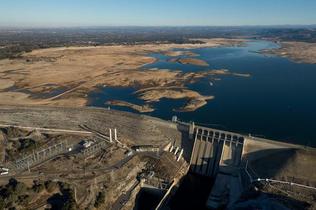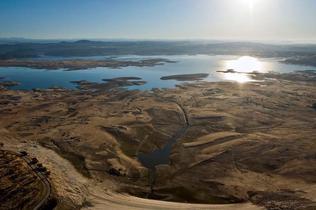California Headed for Record Drought: Will Critically-Needed Reforms Follow?
Confronting a Looming Environmental Disaster

The Sacramento Bee’s fine environmental reporter, Matt Weiser, yesterday reported on a looming, major drought facing California and its regional neighbors.
The figures aren’t pretty. A persistent high-pressure front stretching over the Gulf of Alaska and most of the Northern Pacific has diverted the normal fall and winter storm track away from California and other southwestern states over the past several months. With little precipitation in the first half of this year and hardly any this fall and early winter, 2013 will rank as the driest year in California’s recorded history. In Sacramento, a mere 6.13 inches of rain fell this calendar year, compared to an average 20 inches annually. And December 2013 will be remembered as the driest December in the state’s 135-year recorded history as well.
Things don’t look to get better anytime soon. The U.S. Weather Service recently forecast that below-average precipitation is likely throughout Northern California in January as well.
In response, several California communities are imposing water conservation orders and are considering rationing. The State of California hasn’t taken formal action yet, but Governor Jerry Brown will likely declare a state drought and order emergency measures in the very near future.
Meanwhile, both California’s State Water Project and the federal government’s Central Valley Project have notified their customers of anticipated, severe cutbacks in project water deliveries in 2014.
Farmers faced with those water delivery cutbacks can be expected to respond as they have in the past under similar circumstances: by dramatically increasing groundwater pumping in an effort to offset the losses in surface water deliveries. That’s possible because California, unlike other Western states, has no statewide system of groundwater regulation. So landowners in California’s Central Valley are free to pump as much groundwater as they can.
That, in turn, is likely to have major consequences: continued depletion of the state’s groundwater basins; collapse of underground aquifers that won’t be able to be restored to provide long-term water storage; and increased subsidence of surface areas, exacerbating recent, alarming trends in parts of California’s San Joaquin Valley.

California’s looming drought won’t just threaten state agricultural and urban water users. The other major losers are the fish and other plant and animal species that depend on the state’s extensive system of rivers and lakes for their survival. California’s anadromous salmon populations, for example, have experienced alarming declines over the past several decades–even in relatively “wet” years. (My U.C. Davis faculty colleague, renown fish biologist Peter Moyle, has just published a good op-ed piece on those trends, also in the Bee.) Those species will be especially imperiled in 2014 as a result of the looming drought. And, unlike California farmers, the salmon and other fish species have no water “ace in the hole” they can play to compensate for the water resource losses California’s new drought is already producing.
The state courthouse in Sacramento across from the State Capitol bears the inscription, “Give Me Men to Match My Mountains.” One wonders whether California’s political leaders and resource managers are similarly capable of responding to this emerging, record-setting drought with the menu of enlightened short- and long-term water reforms necessary to stave off a growing environmental disaster that threatens both the state’s human and natural species.
Reader Comments
One Reply to “California Headed for Record Drought: Will Critically-Needed Reforms Follow?”
Comments are closed.






1876 and 1877, so dry, ranchers lost 3/4 of their live stock, r forced to sell at below market price, our last Calif ,Gov, meant well, he tried to build 3 dams, around Sacramento river, he was taken and fooled by the lead ban group, he gave in, sign the lead law ban, in return for dams to be built. Calif will never be able to fix their large thrust, for water. Gov can never agree on any worth while life saving project. once Calif,s farmers go under, you will have your first state, to be in the major depression, forecasted, by experts. Divert money from welfare, or clean it up, fire half of Cal-trans top people, give our prison system, and prisoners, to China, that will save us, billions $, giving us the funs to build dams, reclaimed water for ag, and large green belt areas, and salt water, treatment plants. m population growth, should be control, fast. freeways, change out the veg growing there now, to more drought hardy plants, we need to think like Arizona, AND pray to God, your not hit with a major earth quake, at this time, it will only speed up the destruction of the long lasting drought. pick 5 people, give them the right to do what is necessary to build dams, where ever, no one can stop them. I would rather see 100 small dams, then 2 supper large dams built. screw the union, set the wage scale, fairly, pay people to work hard, or fire them, top to bottom people, George S Patton, could rebuild Germany, in 9 months, after its destruction, we surely can build 100 small dams . build large reservoirs, to hold reclaimed water, only to be used at night time watering, and fire fighting needs.